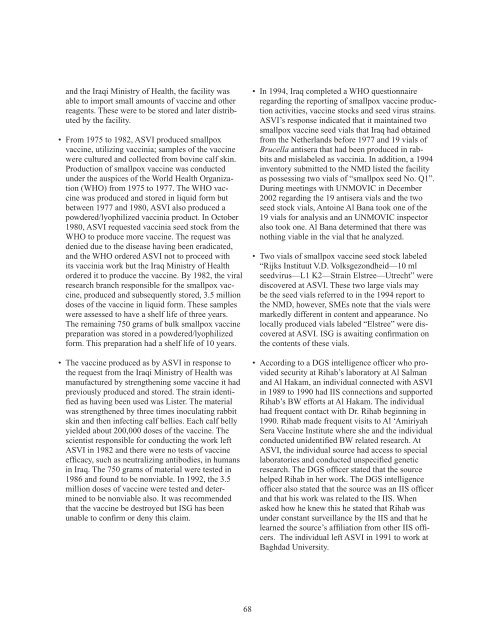Comprehensive Report
GPO-DUELFERREPORT-3
GPO-DUELFERREPORT-3
- No tags were found...
Create successful ePaper yourself
Turn your PDF publications into a flip-book with our unique Google optimized e-Paper software.
and the Iraqi Ministry of Health, the facility was<br />
able to import small amounts of vaccine and other<br />
reagents. These were to be stored and later distributed<br />
by the facility.<br />
• From 1975 to 1982, ASVI produced smallpox<br />
vaccine, utilizing vaccinia; samples of the vaccine<br />
were cultured and collected from bovine calf skin.<br />
Production of smallpox vaccine was conducted<br />
under the auspices of the World Health Organization<br />
(WHO) from 1975 to 1977. The WHO vaccine<br />
was produced and stored in liquid form but<br />
between 1977 and 1980, ASVI also produced a<br />
powdered/lyophilized vaccinia product. In October<br />
1980, ASVI requested vaccinia seed stock from the<br />
WHO to produce more vaccine. The request was<br />
denied due to the disease having been eradicated,<br />
and the WHO ordered ASVI not to proceed with<br />
its vaccinia work but the Iraq Ministry of Health<br />
ordered it to produce the vaccine. By 1982, the viral<br />
research branch responsible for the smallpox vaccine,<br />
produced and subsequently stored, 3.5 million<br />
doses of the vaccine in liquid form. These samples<br />
were assessed to have a shelf life of three years.<br />
The remaining 750 grams of bulk smallpox vaccine<br />
preparation was stored in a powdered/lyophilized<br />
form. This preparation had a shelf life of 10 years.<br />
• The vaccine produced as by ASVI in response to<br />
the request from the Iraqi Ministry of Health was<br />
manufactured by strengthening some vaccine it had<br />
previously produced and stored. The strain identified<br />
as having been used was Lister. The material<br />
was strengthened by three times inoculating rabbit<br />
skin and then infecting calf bellies. Each calf belly<br />
yielded about 200,000 doses of the vaccine. The<br />
scientist responsible for conducting the work left<br />
ASVI in 1982 and there were no tests of vaccine<br />
efficacy, such as neutralizing antibodies, in humans<br />
in Iraq. The 750 grams of material were tested in<br />
1986 and found to be nonviable. In 1992, the 3.5<br />
million doses of vaccine were tested and determined<br />
to be nonviable also. It was recommended<br />
that the vaccine be destroyed but ISG has been<br />
unable to confirm or deny this claim.<br />
• In 1994, Iraq completed a WHO questionnaire<br />
regarding the reporting of smallpox vaccine production<br />
activities, vaccine stocks and seed virus strains.<br />
ASVI’s response indicated that it maintained two<br />
smallpox vaccine seed vials that Iraq had obtained<br />
from the Netherlands before 1977 and 19 vials of<br />
Brucella antisera that had been produced in rabbits<br />
and mislabeled as vaccinia. In addition, a 1994<br />
inventory submitted to the NMD listed the facility<br />
as possessing two vials of “smallpox seed No. Q1”.<br />
During meetings with UNMOVIC in December<br />
2002 regarding the 19 antisera vials and the two<br />
seed stock vials, Antoine Al Bana took one of the<br />
19 vials for analysis and an UNMOVIC inspector<br />
also took one. Al Bana determined that there was<br />
nothing viable in the vial that he analyzed.<br />
• Two vials of smallpox vaccine seed stock labeled<br />
“Rijks Instituut V.D. Volksgezondheid—10 ml<br />
seedvirus—L1 K2—Strain Elstree—Utrecht” were<br />
discovered at ASVI. These two large vials may<br />
be the seed vials referred to in the 1994 report to<br />
the NMD, however, SMEs note that the vials were<br />
markedly different in content and appearance. No<br />
locally produced vials labeled “Elstree” were discovered<br />
at ASVI. ISG is awaiting confirmation on<br />
the contents of these vials.<br />
• According to a DGS intelligence officer who provided<br />
security at Rihab’s laboratory at Al Salman<br />
and Al Hakam, an individual connected with ASVI<br />
in 1989 to 1990 had IIS connections and supported<br />
Rihab’s BW efforts at Al Hakam. The individual<br />
had frequent contact with Dr. Rihab beginning in<br />
1990. Rihab made frequent visits to Al ‘Amiriyah<br />
Sera Vaccine Institute where she and the individual<br />
conducted unidentified BW related research. At<br />
ASVI, the individual source had access to special<br />
laboratories and conducted unspecified genetic<br />
research. The DGS officer stated that the source<br />
helped Rihab in her work. The DGS intelligence<br />
officer also stated that the source was an IIS officer<br />
and that his work was related to the IIS. When<br />
asked how he knew this he stated that Rihab was<br />
under constant surveillance by the IIS and that he<br />
learned the source’s affiliation from other IIS officers.<br />
The individual left ASVI in 1991 to work at<br />
Baghdad University.<br />
68


